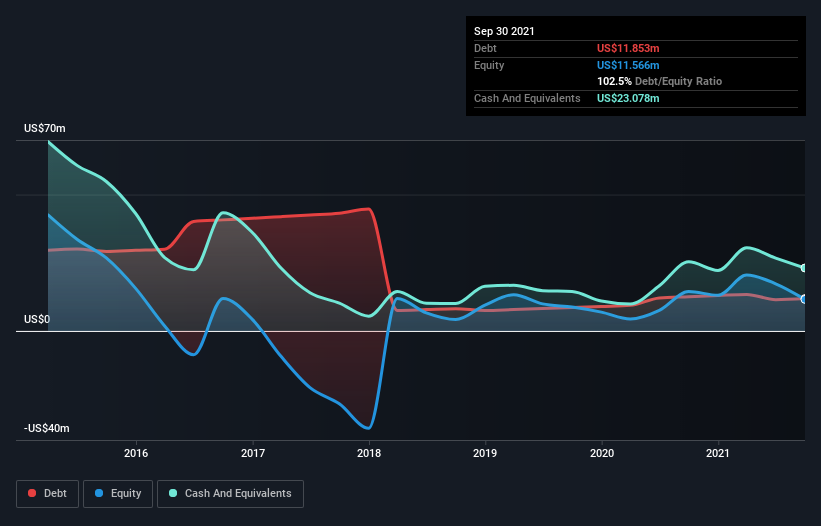Health Check: How Prudently Does Avinger (NASDAQ:AVGR) Use Debt?
Legendary fund manager Li Lu (who Charlie Munger backed) once said, 'The biggest investment risk is not the volatility of prices, but whether you will suffer a permanent loss of capital.' So it might be obvious that you need to consider debt, when you think about how risky any given stock is, because too much debt can sink a company. We can see that Avinger, Inc. (NASDAQ:AVGR) does use debt in its business. But the more important question is: how much risk is that debt creating?
Why Does Debt Bring Risk?
Generally speaking, debt only becomes a real problem when a company can't easily pay it off, either by raising capital or with its own cash flow. If things get really bad, the lenders can take control of the business. However, a more frequent (but still costly) occurrence is where a company must issue shares at bargain-basement prices, permanently diluting shareholders, just to shore up its balance sheet. By replacing dilution, though, debt can be an extremely good tool for businesses that need capital to invest in growth at high rates of return. When we think about a company's use of debt, we first look at cash and debt together.
Check out our latest analysis for Avinger
How Much Debt Does Avinger Carry?
You can click the graphic below for the historical numbers, but it shows that Avinger had US$11.9m of debt in September 2021, down from US$12.5m, one year before. However, it does have US$23.1m in cash offsetting this, leading to net cash of US$11.2m.
A Look At Avinger's Liabilities
Zooming in on the latest balance sheet data, we can see that Avinger had liabilities of US$7.44m due within 12 months and liabilities of US$14.7m due beyond that. On the other hand, it had cash of US$23.1m and US$1.40m worth of receivables due within a year. So it can boast US$2.31m more liquid assets than total liabilities.
This short term liquidity is a sign that Avinger could probably pay off its debt with ease, as its balance sheet is far from stretched. Succinctly put, Avinger boasts net cash, so it's fair to say it does not have a heavy debt load! The balance sheet is clearly the area to focus on when you are analysing debt. But ultimately the future profitability of the business will decide if Avinger can strengthen its balance sheet over time. So if you want to see what the professionals think, you might find this free report on analyst profit forecasts to be interesting.
Over 12 months, Avinger reported revenue of US$10m, which is a gain of 22%, although it did not report any earnings before interest and tax. Shareholders probably have their fingers crossed that it can grow its way to profits.
So How Risky Is Avinger?
By their very nature companies that are losing money are more risky than those with a long history of profitability. And in the last year Avinger had an earnings before interest and tax (EBIT) loss, truth be told. And over the same period it saw negative free cash outflow of US$15m and booked a US$21m accounting loss. Given it only has net cash of US$11.2m, the company may need to raise more capital if it doesn't reach break-even soon. Avinger's revenue growth shone bright over the last year, so it may well be in a position to turn a profit in due course. By investing before those profits, shareholders take on more risk in the hope of bigger rewards. There's no doubt that we learn most about debt from the balance sheet. But ultimately, every company can contain risks that exist outside of the balance sheet. These risks can be hard to spot. Every company has them, and we've spotted 4 warning signs for Avinger (of which 1 is significant!) you should know about.
If, after all that, you're more interested in a fast growing company with a rock-solid balance sheet, then check out our list of net cash growth stocks without delay.
Have feedback on this article? Concerned about the content? Get in touch with us directly. Alternatively, email editorial-team (at) simplywallst.com.
This article by Simply Wall St is general in nature. We provide commentary based on historical data and analyst forecasts only using an unbiased methodology and our articles are not intended to be financial advice. It does not constitute a recommendation to buy or sell any stock, and does not take account of your objectives, or your financial situation. We aim to bring you long-term focused analysis driven by fundamental data. Note that our analysis may not factor in the latest price-sensitive company announcements or qualitative material. Simply Wall St has no position in any stocks mentioned.

